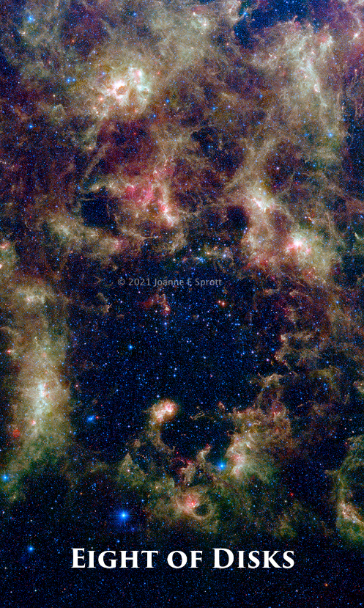Available from the creator, Joanne Sprott, at: https://divinephysicstarot.com/
Copyright © 2020 by Joanne E Sprott
ISBN: 978-1-7363800-1-7
Deck Price: $38.00
Book (B/W softcover paper): $25.99
Book (colour PDF): $6.00
Bag (created by our very own Ania M!): $21.99
(Prices as at time of writing this review.)
The creator of this deck is TABI’s Joanne Sprott, one of our former Chairs. As well as being a professional tarot reader, she’s also a book indexer and editor, so – as you might expect – she’s provided a beautifully written and well-laid out companion book to her deck.
First things first. The deck does not come in a box. I assume this is for practical purposes such as ease of posting (Joanne is based in the north-western US); my deck came bundled in purple ribbon, and well-packaged. The 78 (plus one cover) cards are a fairly standard size (7cm x 12cm), of good-quality stock, and are easy to hold and shuffle. Each card has its name at the bottom, which is probably a good thing, unless you are an expert at cosmological identification!
I chose the PDF version of the book, although I am now regretting that a bit, as I like to have the reference close at hand, rather than having to switch on the computer! The book is, I feel, essential if you want to understand Joanne’s choices of images for the cards. At 136 pages, it’s chock-full of information.
I also chose not to go for the bag, lovely though it is. I like making my own bags for decks. (Sorry, Ania!)
So, on to the good stuff.
To quote Joanne, from the book: “I’ve just assembled some pictures from the Universe’s travel album to enlighten your own path. We’ve got physics and astronomy, metaphysics and mythology, and some stories sprinkled in to make it more fun.”
I would question her use of the word “just” in that first sentence, as this is truly a huge piece of work/art. I’d use the word “astronomical” to describe the effort that’s gone into this, but that may be too much for some of you! So much thought has gone into the selection of image for each card – which she explains in the book, not to mention the stories she includes. The images, I should add, are all from NASA and related, or university, observatories, and a complete source list is provided at the end of the book.
The first part of the book covers Joanne’s philosophy of tarot, as well as explanation of the symbolism she draws on. Most of the images have been chosen with the RWS deck in mind, although she also refers to the Thoth deck on occasion.
She also includes five spreads of her own devising at the end of this section, some of which I’ve been playing with. They are all based on physics or cosmological concepts – the Gravity Wave, the Quantum Focus, for example – but don’t let the titles put you off. They are all thought-provoking!
The book goes on to look at the Major Arcana, followed by the four minor suits (Cups, Disks, Swords, and Wands). Each card has its own page (two in the case of the Majors), including the image, keywords, the “Physics” (what the image is, and why Joanne chose it), and the “Metaphysics and Message” (the interpretation). The Majors also have a bonus in “The Story”, pieces of Joanne’s poetry to illustrate the Journey.
The cards are stunning. I’ve always found images of our universe to be awe-inspiring and breath-taking, and I have to admit that’s one of the reasons why I’ve coveted this deck, ever since I knew Joanne was creating it. I did wonder whether this particular topic was going to make it hard to relate to the card images in terms of traditional tarot interpretation, and while I would not recommend this deck to a beginner, I have been impressed at the ease in which I can see RWS-type imagery in the galaxies and nebulae depicted.
Some obvious ones are The Sun, The Moon, The Wheel, and The Tower. While there may not be figures falling from the tower here, the matter that’s being thrown out from the centre of the galaxy is, as Joanne writes, “a very dramatic combination of capture (in the black hole) and breaking free”.


The images for the Ace of Wands and Three of Swords also don’t require much imagining to see more traditional depictions within them.


Less obvious perhaps, Temperance – although I can see a figure rising up in the upper half of the card, with a face looking downwards, and two arms extending outwards, holding vessels. I like the idea that Joanne proposes – the blue representing water, the red fire, all blending together.

In the Nine of Cups I can see the RWS figure (and also the Wildwood’s Nine of Vessels fellow!), with his hands folded – even without Joanne’s prompt!


Some of the images do require more imagination, but I have to say that, for me, they are in the minority. The Eight of Disks is a good example of this. I needed the prompt from the book to see the figure at work, sitting before the great window of space behind. I’m still not sure I can see the apprentice’s master looking down from the left, as Joanne can, but I’m working (very Eight of Disks) on it!

Joanne writes that she’s chosen her images to be “a kind of Rorschach test”, and that the deck is more likely to appeal to those who enjoy “the challenge of reading from an impressionistic” view. For me, it’s not unlike reading with the Margarete Petersen deck (one of my favourites), although I can now identify over half of the images without looking at the card’s title. Again, perhaps not a deck for beginners. As for me, I’m star-struck!
So, long story short – if you love images of the universe, and enjoying searching for visual clues in your tarot cards, you will love this deck. Do invest in the book as well, as it’s a treasure-trove in its own right.
Review by Alison Coals


